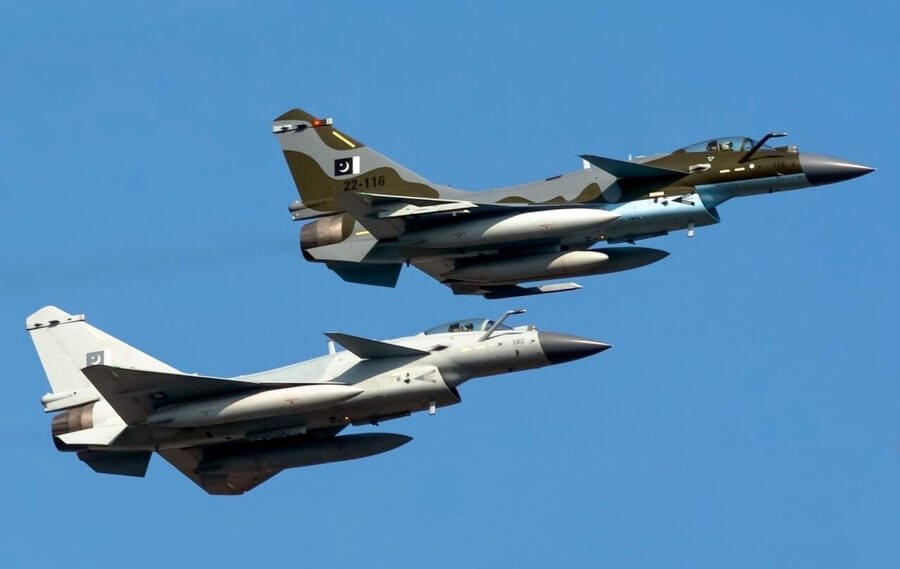By Sarina Tareen
The current India-Pakistan escalation is not just a cross-border tension. It is the turning point to a larger strategic shift, where China is largely perceived to flaunt its military might, Donald Trump reiterates his diplomatic expertise, Russia flexes its military muscles, Iran comes across as a mediator, and new emerging technologies blur the line between military signaling and physiological warfare.

The Indian-Pakistani conflict presents itself as a pivot where regional actors test their deterrence strategies, exert their influence, and decide the future warfare of South Asia.
Pakistan lies at the center of this complex regional chessboard. “Operation Bunysan UI Marsoos”, launched in retaliation to counter the “Operation Sindoor” following the Pahalgam attack, asserted a unified civil-military collaboration. The application of Chinese-made J-10C fighter jets, and an effective anti-aircraft defense system not only uplifted the domestic morale. Besides, it questioned the air supremacy of India by shooting down the Rafale aircraft, resulting in a €5.40 dip in the value of Dassault Aviation’s stocks.
Pakistan was not alone in this display of strategic assertiveness. Leveraging this situation, China not only as a partner, but as a key ally, conducted a live test. Reports confirm China successfully tested its hypersonic missile and next-generation radar systems with 100% accuracy in the Gobi Desert. More significantly, Chinese researchers conducted a non-nuclear hydrogen bomb, which uses magnesium hydride to produce a stable 1,000 °C fireball.
Furthermore, the implications of this test are far-reaching. While not a nuclear detonation, the Hydrogen Bomb without a nuclear trigger showcases the mastery of advanced physics and engineering. It further complicates the global balance of power in the South Asian region. This is about influence. The message is clear: China now possesses the ability to replicate the destructive force of a nuclear weapon without violating any international treaty. By mastering non-nuclear thermal nuclear technology.
In the course of this developing situation, Donald Trump re-emerged strongly, declaring a ceasefire between India and Pakistan. Trump’s message symbolized America’s enduring presence in South Asia, despite the rise of BRICS. His rhetorical promise to resolve the Kashmir issue “after thousands of years” this statement was intentional and symbolic. By measured involvement and diplomacy, the US reaffirms its profile without an excessive military footprint, but focuses on shaping the global perception.
Amidst all this, Iran established itself as a shocking promoter of peaceful diplomacy in the region. Once painted as a disrupter, Tehran’s diplomatic communication and efforts to de-escalate tensions showed its new positioning as a mediator in the region. Emphasizing the shift in the geopolitical dynamics across West and South Asia.
Yet, not all are convinced of India’s strategy. In a stinging critique, Rahul Gandhi accused the Modi government of fusing contradictory foreign policy doctrines, driving China and Pakistan into deeper military alignment. He denounced the Rafale fighter jet deal as a strategic mistake. He further explained that the BJP’s radical nationalist approach has weakened New Delhi’s diplomatic power while hardening India’s adversaries. He criticizes the Modi government’s foreign policy approach, which was truly based on strategic overreach and diplomatic rigidity.
Meanwhile, Russia has shut its airspace over Kapustin Yar Missile Range, possibly hinting at new ICBM test trials. A subdued yet powerful observer, Israel has been polishing its military technology amid the Indo-Pak tensions. All major players, China, Russia, the U.S., and Israel, are using the South Asian regional tension for their benefit.
The dynamics of war have changed. Beyond the frontline, Pakistan pushed the war into the cyber world, where it launched a series of covert “cyberattacks” that hit India’s digital nerve. By hacking several Indian defense websites, and jamming the key military satellites. Hackers also targeted the official website of the BJP, India’s ruling party, challenging the government’s cyber readiness. This is a shift to hybrid warfare, where propaganda, deep fakes, cyber sabotage, and strategic leaks matter as much as missiles. In this current era of warfare, perception becomes power.
For Prime Minister Modi, the Indo-Pak tensions have always served as a political catalyst. His government has revived its tested playbook as a general election approach: external threat, strong counterattack, and electoral triumph. It echoes past patterns such as Uri 2016, Pulwama 2019, and now Operation Sindoor 2025. As stated by U.S. President Franklin D. Roosevelt, “In politics, nothing happens by accident. If it happens, you can bet it was planned that way.”
Each incident positioned Modi as a sole protector of Indian sovereignty, allowing his party to suppress domestic critics and shift public attention to the national security threat. The BJP campaign is now deeply rooted in its “zero tolerance to terrorism”. Simultaneously, India’s readiness to enter ceasefire diplomacy allows it to maintain its global credibility. Regardless of its refusal to possibly accept external mediation concerning the Kashmir issue. This dual approach improves its domestic support while also helping in winning international support.
Yet, there is a large strategic price to pay. India now finds itself surrounded by adversaries getting closer. India’s diplomatic choices are reduced, and military tensions in the region are intensified by the adoption of an aggressive strategy. Meanwhile, Pakistan, backed by its key ally China, has surpassed defensive tactics for narrative supremacy, using both defensive victories and cyber advantage to shift the global perception.
Nevertheless, what appears to be amusing is a complex, serious fact. The rules of conflict have changed. Deterrence is now digital, and superiority of one state over another is now psychological.
Author: Sarina Tareen – Research Intern at Balochistan Think Tank Network (BTTN), International Relations graduate from BUITEMS, Quetta, Pakistan.
(The views expressed in this article belong only to the author and do not necessarily reflect the editorial policy or views of World Geostrategic Insights).







